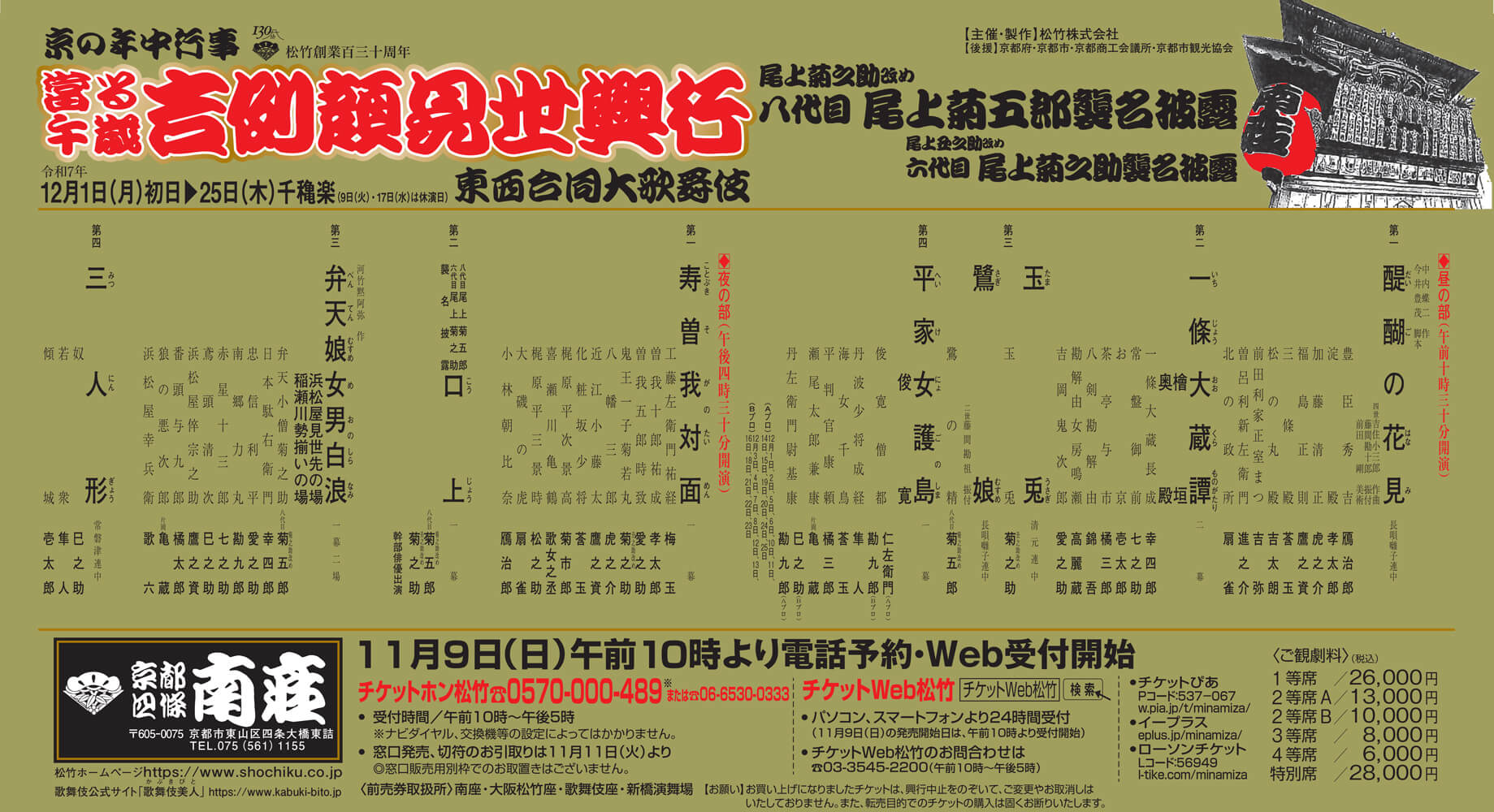Minamiza Theatre
December Program at the Minamiza Theatre
Daily: Dec 01 (Mon) - Dec 25 (Thu), 2025
Matinee:10:30 AM
Evening Show: 4:30 PM
*No performances on the 9th (Tue) and 17th (Wed).
*Reserved seats for the Matinee are sold out on the 20th (Sat).
On sale: from Nov 09 (Sun), 2025 10:00 AM(JST)
First Class Seat: 26,000 /Second Class Seat A: 13,000 / Second Class Seat B: 10,000 / Third Class Seat: 8,000 / Fourth Class Seat: 6,000
*Children over the age of 4 must purchase tickets to enter.
Unit: Japanese Yen (tax included)
*Special Seat: 28,000 (Not available online. Click here for details.)
Minamiza Theatre (at KYOTO) Theatre Information
- *No English supporting guide available.
- *Free English flyer available.
[An Annual Event in Kyoto - The Festive Kaomise Production, Grand Kabuki Starring Actors from East and West]
The 'Kaomise' ('face-showing') production which has been staged annually since the Edo period (1603-1868) is an all-star line-up and a
big event for December in Kyoto.
The Matinee begins with a dance drama set in Kyoto, followed by a classic period piece rich with highlights. Next comes the 'shūmei' (name-succession) presentation piece — a double bill featuring a popular light-hearted dance with Kiyomoto music, paired with another dance expressing beauty and transience. The Matinee concludes with a famous historical masterpiece which is a poignant depiction of human conscience and loneliness.
The Evening Show begins with a celebratory drama full of formal elegance, followed by a 'kōjō', the traditional on-stage address celebrating this month's name succession. Next, enjoy a lively Otowaya family classic about five thieves, and finally a dance in which 'puppets' charmingly depict the life of the pleasure quarters.
 Minamiza Theatre Stage Photo
Minamiza Theatre Stage Photo
DAIGO NO HANAMI
['Cherry Blossom Viewing at the Daigoji Temple']
CAST :
- Toyotomi Hideyoshi
- Nakamura Ganjirō
- Lady Yodo
- Kataoka Takatarō
- Sorori Shinzaemon
- Kataoka Shinnosuke
- Hideyoshi’s lawful wife
- Nakamura Senjaku
STORY :
This is a dance portraying the famous blossom-viewing party held by the warlord Toyotomi Hideyoshi in the 3rd lunar month of 1598 in the garden of Daigoji Temple in Kyoto. It was a grand banquet to which Hideyoshi's family, many daimyō lords, their wives and retainers were invited.
Intermission: 15 minutes
ICHIJŌ ŌKURA MONOGATARI
Higaki, Okuden
[''Higaki Tea Stall' and 'Inner Drawing Room of Ōkura's Mansion' from 'The Tale of Ichijō Ōkura'']
CAST :
- Ichijō Ōkura Naganari
- Matsumoto Kōshirō
- Lady Tokiwa
- Nakamura Shichinosuke
- Okyō
- Nakamura Kazutarō
- Naruse, Kageyu’s wife
- Ichikawa Komazō
- Yoshioka Kijirō
- Kataoka Ainosuke
STORY :
This is a 'jidaimono' history play set in the 12th century. The Genji retainer Kijirō and his wife Okyō believed that Lady Tokiwa, the widow of the Genji leader Yoshitomo, had given up on her clan's struggle against the enemy Heike, but they rejoice to find that she secretly prays for the Heike's downfall. However, when Yatsurugi Kageyu, one of the retainers of her current husband, the aristocrat Ōkura, discovers this, he declares that he will tell Kiyomori about Lady Tokiwa's secret. He is killed by Ōkura. Though Ōkura seems to be nothing more than a fool, this is actually an elaborate disguise to survive in this turbulent world.
Intermission: 35 minutes
TAMA USAGI / SAGI MUSUME
['The Rabbit in the Moon' / 'The Heron Maiden']
CAST :
- Tama Usagi
- Onoe Kikunosuke, changing his name from Onoe Ushinosuke
- The spirit of a heron
- Onoe Kikugorō VIII, changing his name from Onoe Kikunosuke
Tama Usagi
SAGI MUSUME
STORY :
This is a dance with musical accompaniment provided by the Kiyomoto Narrative Ensemble. It is the night of a full autumn moon. Looking up at the round moon, we see the shadow of a rabbit making rice dumplings. Before long, it springs out, landing in a field of pampas grass. It proceeds to demonstrate how it makes rice dumplings with a pestle and mortar. On this moonlit night, the rabbit seems in festive mood and continues to make merry through the night.
A woman dressed in a white kimono and hood appears at the edge of a lake. Her dance includes bird-like movements resembling those of a white heron. She expresses the misery of one whose love was betrayed. A sudden onstage costume change begins a section in which the character transforms into a young girl preoccupied by thoughts of romance. Other costume changes follow, as the maiden expresses the difficulty of capturing a loved one's heart. Finally, the stage darkens and after another spectacular costume change, the maiden transforms into the spirit of a heron as she recalls her suffering in hell.
Intermission: 25 minutes
HEIKE NYOGO NO SHIMA
Shunkan
[''The Priest Shunkan' from 'The Heike and the Island of Women'']
CAST :
- Priest Shunkan
- Kataoka Nizaemon (Program A)
- Nakamura Kankurō (Program B)
- Tanba no Shōshō Naritsune
- Nakamura Hayato
- Chidori, a woman diver
- Nakamura Kangyoku
- Seno’o no Tarō Kaneyasu
- Bandō Hikosaburō
- Tanba Saemon no jō Motoyasu
- Bandō Minosuke (Program B)
- Nakamura Kankurō(Program A)
※A Program(12/1・2・5・6・10・11・14・15・19・20・24・25)
※B Program(12/3・4・7・8・12・13・16・18・21・22・23)
STORY :
The priest Shunkan has been exiled to "Devil's Island" for plotting against the dictator Kiyomori. After some years, a pardon is given to Shunkan and his fellow conspirators. However, as he hears that his wife has died in Kyoto, Shunkan gives up his place on the boat to freedom so that one of his companions’ new wife can accompany her husband back to the capital. The boat leaves and Shunkan is left watching it disappear in the distance, knowing he will be left on the island forever. Enjoy this masterpiece of the 'jidaimono' history play category.
KOTOBUKI SOGA NO TAIMEN
['The Auspicious Confrontation of the Soga Brothers']
CAST :
- Kudō Saemon Suketsune
- Nakamura Baigyoku
- Soga no Jūrō Sukenari
- Kataoka Takatarō
- Soga no Gorō Tokimune
- Kataoka Ainosuke
- Kikuwakamaru, Oniō’s son
- Onoe Kikunosuke, changing his name from Onoe Ushinosuke
- Yawata no Saburō
- Nakamura Toranosuke
- Ōmi no Kotōda
- Nakamura Takanosuke
- Kewaizaka no Shōshō
- Nakamura Kangyoku
- Ōiso no Tora
- Nakamura Senjaku
- Kobayashi no Asahina
- Nakamura Ganjirō
STORY :
This scene is one act of a history play based on the legend of the Soga brothers' vendetta. In the Edo period, plays about the vendetta carried out by the Soga brothers, Gorō and Jūrō, were performed at times of celebration. 'Soga no Taimen', in which the brothers meet their nemesis, has its roots in the earliest of these plays. This play has ceremonial aspects and features each of the important kabuki character types, including the bombastic 'aragoto' style of Gorō and the soft 'wagoto' style of Jūrō.
Intermission: 25 minutes
Shūmei Hirō KŌJŌ
['Stage Announcement Commemorating the Name Succession']
STORY :
The actors will appear as themselves to make a stage announcement to commemorate the name succession.
Intermission: 35 minutes
BENTEN MUSUME MEO NO SHIRANAMI
Hamamatsuya Misesaki / Inasegawa Seizoroi
['The Hamamatsu-ya Textile Shop' and 'The Gathering along the Inase River Bank' from 'The Five Thieves']
CAST :
- Benten Kozō Kikunosuke
- Onoe Kikugorō VIII, changing his name from Onoe Kikunosuke
- Nippon Daemon
- Matsumoto Kōshirō
- Tadanobu Rihei
- Kataoka Ainosuke
- Nangō Rikimaru
- Nakamura Kankurō
- Akaboshi Jūzaburō
- Nakamura Shichinosuke
- Seiji, the chief of a fire brigade
- Bandō Minosuke
- Sōnosuke, Kōbē’s son
- Nakamura Takanosuke
- Kōbē, owner of the Hamamatsuya
- Nakamura Karoku
STORY :
Written by the famous playwright Kawatake Mokuami, this play is a wonderful display of kabuki's stylized beauty and includes a dynamic fight scene that is performed on a particularly gorgeous stage set. In the story, a beautiful woman is suspected of shoplifting and is beaten. When it is proved that she was not stealing, her servant demands compensation. However, a samurai who happens to be present uncovers their ruse and reveals that the woman is actually a man. The former 'woman' and her accomplice are, in fact, Benten Kozō and Nangō Rikimaru, two members of the same infamous gang of thieves. Even the samurai who supposedly exposed their plot turns out to be none other than Nippon Daemon, the head of this gang. Finally, the gang is hunted down by officers and when they are surrounded, the five gang members remain defiant, delivering elaborate rhythmic speeches dressed in their finest kimono and accompanied by beautiful music.
Intermission: 15 minutes
MITSU NINGYŌ
['The Three Dolls']
CAST :
- A footman
- Bandō Minosuke
- A young samurai
- Nakamura Hayato
- A courtesan
- Nakamura Kazutarō
STORY :
This is a dance with an antique atmosphere accompanied by the Tokiwazu Narrative Ensemble. Taken out from their boxes, the dolls of a courtesan, a suave samurai and his light-footed servant begin to move, each possessed by the characters' souls. They portray in dance a night in the pleasure quarters accompanied by the gay tones of the 3-stringed shamisen.


